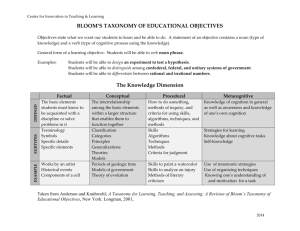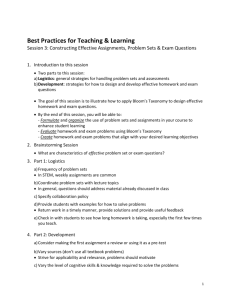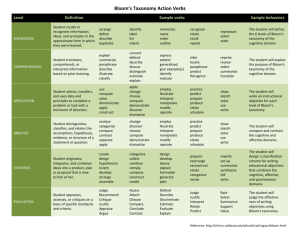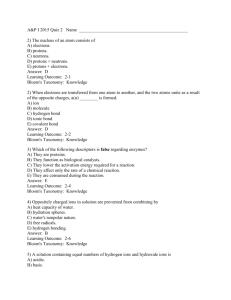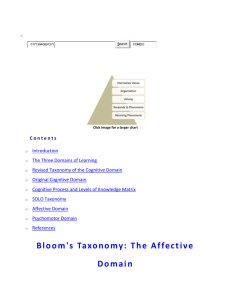Engaging Students in Online Discussion
advertisement
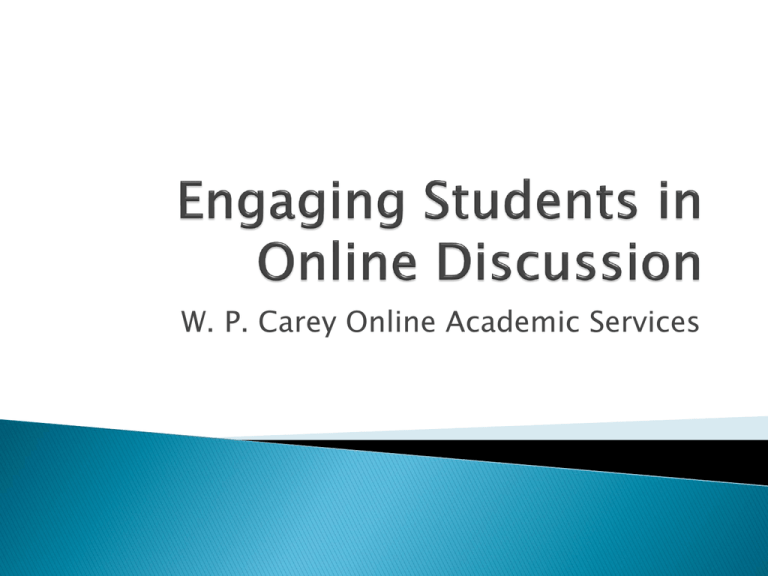
W. P. Carey Online Academic Services F2F, we rely on verbal and visual communication to discuss class topics Some students contribute, some just listen and take notes Participation is not necessarily required or graded We assume by being in class, students are absorbing information Online discussion is different Require facilitation by the instructor Must be structured Instructor must be aware of the different strategies and techniques needed to facilitate online instruction Instructors need to find the online discussion technique(s) that works for their class How can you promote student engagement in the discussion board? What types of questions do you ask? What can you do to keep the conversation going? How much time will discussion boards take to facilitate? Bonding and social interaction are important Social cues need to be brought in by the instructor Start by having students introduce themselves The more shared knowledge students have of one another, the more sharing of social cues The more social cues, the more motivated they will be to participate in online discussion Provide the rules of Netiquette that you expect Outline the traits you expect to see ◦ ◦ ◦ ◦ ◦ Positive Sensitive Considerate Polite Tolerant Critique an online article or website ◦ Keep a list as you find these for your next class Debate or discuss a controversial topic ◦ Have students take a side ◦ Make sure all are being respectful Form teams for group discussions ◦ Can then report back to the whole class ◦ Smaller teams makes easier discussion Count discussion towards grades Define participation requirements ◦ Guide, checklist or rubric ◦ Give requirements to each student State beginning and end dates for contributions Encourage Netiquette ◦ Polite discourse adds value When possible, ask students to relate the material to personal experiences ◦ Increases motivation to respond ◦ Connects prior knowledge to new knowledge Create extra discussion areas for small group work When asked a question from a student, give prompt response Inform students of what you consider timely feedback Do not feel you need to respond to every student in the discussion ◦ Get the conversation started ◦ Stay in the background, but keep them on track ◦ Summarize at the end of the discussion Use the discussion board for exam preparation Have students provide exam questions to the discussion Recommend extra stuff ◦ At some point, send recommend a book, website, movie ◦ Tell the students why this recommendation is important Use white space ◦ No one will read a long block of text Use the book, but don’t teach the book Pre-write your questions ◦ Even replies Well structured questions ◦ Open-ended Participation requirements ◦ Example 1 initial post, 3 responses to classmates “Something to think about” Great for those who do not like public speaking What is Bloom’s Taxonomy? Bloom’s Taxonomy is a useful tool for instructors to assist with the formation of assessments at the desired level of learning. Some lessons and classes are very appropriate for usage of the lower level of the taxonomy; other courses and lessons should require higher levels of cognitive mastery. Evaluate a recent test/assessment that you have been exposed to as a learner. Discuss the level of Bloom’s (cognitive level) this test/assessment measured? In your opinion, was this an appropriate level of cognitive measurement for the course/activity? Why or why not? Recommend a more appropriate assessment for the situation and defend your recommendation Please be sure to respond to 2 of your classmate's posts as well in order to earn full credit for the question. Use different types of questions Do not use questions with only one answer Ask open-ended questions Ask higher-order thinking questions (Bloom’s Taxonomy) Ask probing questions (Socratic method) Play Devil’s advocate Ask for clarification Make students defend answers Include the assessment criteria in the course ◦ Syllabus ◦ Course announcement ◦ Instructions for questions Make sure the criteria measure both quality and quantity A rubric can be helpful Students feeling overwhelmed by too much information ◦ Plan and streamline discussions Unorganized conversations confuse students ◦ Time release ◦ State dates for conversations Students stumped by online tasks ◦ Provide directions if you want items cut and pasted, URLs, etc ◦ Provide guidelines on length, due dates, etc Student comments lack justification/evidence ◦ Model ways to support arguments ◦ Cite research and theories in your own posts Comments unrelated to course readings and course concepts ◦ Students often do not realize this is expected of them ◦ Set expectations-tell students to use readings Students are too nice on the web ◦ Assign devil’s advocate, pessimist, optimist roles to students Peer camaraderie is lacking ◦ Assign online buddies ◦ Tell students who to comment on/interact with Struggling to teach not preach ◦ Don’t lecture in the discussion board ◦ Encourage students to run the discussion topics ◦ Assign leaders each week Difficulty forming a community of learners ◦ Encourage casual interaction ◦ Have a “hanging out” thread Time consuming to grade discussion boards ◦ Students may post high amounts of material ◦ Set grading criteria ◦ Make sure the criteria is based on quality on not quantity ◦ Use the power of Blackboard to assist with grading Technological issues ◦ Try and avoid last minute work ◦ Make sure you and the students know the support available Any Questions? Call or email me with anything Jodi.menees@asu.edu 480-371-0173


